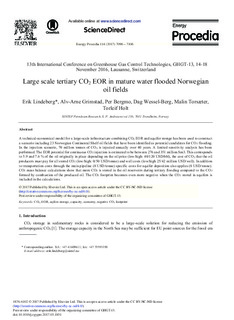| dc.contributor.author | Lindeberg, Erik Gøsta Brun | |
| dc.contributor.author | Grimstad, Alv-Arne | |
| dc.contributor.author | Bergmo, Per Eirik Strand | |
| dc.contributor.author | Wessel-Berg, Dag | |
| dc.contributor.author | Torsæter, Malin | |
| dc.contributor.author | Holt, Torleif | |
| dc.date.accessioned | 2017-08-22T11:53:22Z | |
| dc.date.available | 2017-08-22T11:53:22Z | |
| dc.date.created | 2017-08-19T16:20:14Z | |
| dc.date.issued | 2017 | |
| dc.identifier.citation | Energy Procedia. 2017, 114 7096-7106. | nb_NO |
| dc.identifier.issn | 1876-6102 | |
| dc.identifier.uri | http://hdl.handle.net/11250/2451469 | |
| dc.description.abstract | A technical-economical model for a large-scale infrastructure combining CO2 EOR and aquifer storage has been used to construct a scenario including 23 Norwegian Continental Shelf oil fields that have been identified as potential candidates for CO2 flooding. In the injection scenario, 70 million tonnes of CO2 is injected annually over 40 years. A limited sensitivity analysis has been performed. The EOR potential for continuous CO2 injection is estimated to be between 276 and 351 million Sm3. This corresponds to 5.9 and 7.6% of the oil originally in place depending on the oil price (low/high: 40/120 USD/bbl), the cost of CO2 that the oil producers must pay for all stored CO2 (low/high: 0/50 USD/tonne) and well costs (low/high 25/42 million USD/well). In addition to transportation costs through the main pipeline (8 USD/tonne) specific costs for aquifer deposition also applies (8 USD/tonne). CO2 mass balance calculations show that more CO2 is stored in the oil reservoirs during tertiary flooding compared to the CO2 formed by combustion of the produced oil. The CO2 footprint becomes even more negative when the CO2 stored in aquifers is included in the calculations. | nb_NO |
| dc.language.iso | eng | nb_NO |
| dc.publisher | Elsevier | nb_NO |
| dc.relation.uri | http://www.sciencedirect.com/science/article/pii/S1876610217320532 | |
| dc.rights | Attribution-NonCommercial-NoDerivatives 4.0 Internasjonal | * |
| dc.rights.uri | http://creativecommons.org/licenses/by-nc-nd/4.0/deed.no | * |
| dc.title | Large Scale Tertiary CO2 EOR in Mature Water Flooded Norwegian Oil Fields | nb_NO |
| dc.type | Journal article | nb_NO |
| dc.type | Peer reviewed | nb_NO |
| dc.description.version | publishedVersion | nb_NO |
| dc.source.pagenumber | 7096-7106 | nb_NO |
| dc.source.volume | 114 | nb_NO |
| dc.source.journal | Energy Procedia | nb_NO |
| dc.identifier.doi | 10.1016/j.egypro.2017.03.1851 | |
| dc.identifier.cristin | 1487399 | |
| dc.description.localcode | © 2017 Published by Elsevier Ltd. This is an open access article under the CC BY-NC-ND license (http://creativecommons.org/licenses/by-nc-nd/4.0/). | nb_NO |
| cristin.unitcode | 194,63,15,0 | |
| cristin.unitname | Institutt for matematiske fag | |
| cristin.ispublished | true | |
| cristin.fulltext | original | |
| cristin.qualitycode | 1 | |

